Pune-based architects Dhruvang Hingmire and Priyanka Gunjikar are building houses out of mud, stone, wood and naturally available resources to reduce wastage and promote sustainability.
By using ancient techniques, employing local artisans and labourers, they are also contributing to the village economy.
This is their inspiring story.
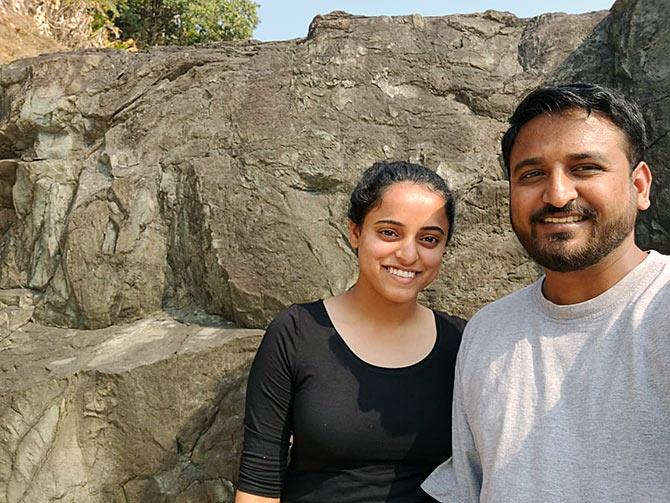
We've all learnt in school how cement is made from limestone.
But did anyone ever tell you that building a cement house (practically most houses in cities) requires 80 to 90 per cent potable water, which can be easily avoided by replacing cement with limestone or mud?
This is just one of the many problems with housing that Mumbai-born architect Priyanka Gunjikar and Pune's Dhruvang Hingmire are trying to address.
Having born in Maharashtra, a state that has several villages suffering from drought and lack of potable water for survival, Pune-based architects Dhruvang Hingmire (son of architect parents) and Priyanka (a gold medallist) were inspired to use their knowledge to educate and show people how to build houses in sync with nature and tradition by using natural and cost effective techniques.
"The tragedy is that limestone is the raw material used to make cement. To make 100 kg of cement, you require 130 kg of limestone. In our country, cement is subsidized but lime isn't. The cost and wastage involved in building cement houses is too much and mostly avoidable. But sadly, the cement and sand mining lobby in our country is so strong that it becomes difficult to convince people what is really good for them and the environment," Dhruvang Hingmire tells Divya Nair/Rediff.com.
"There are lots of myths and misinformation floating around. As architects we are taught to build with cement because it is easily available, more reliable. So, if you break down the budgeting of any house, you'll see that most of the cost is shared by cement, concrete and steel. Why can't we take mud from the site itself, if it is legal? Or use lime plaster instead of cement?" reveals Priyanka.
"We are never taught to question what we are doing or simply ask: Is this necessary? Can we reduce the wastage and be more responsible?" she adds.
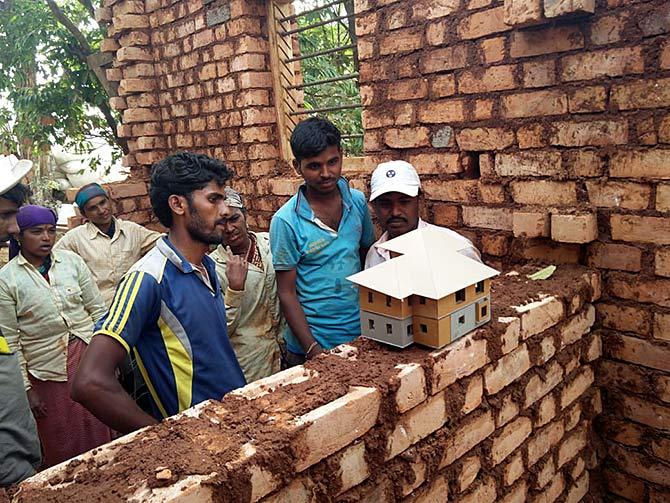
Armed with these ideas and findings, four years ago, the duo who graduated Rachana Sansad Academy of Architecture, Dadar in 2015 ditched the lure of a six figure salary, an air-conditioned office and took the road less travelled.
The now married couple is reviving India's ancient methods of building houses and in the process found alternate methods of construction and sustenance, which is slowly getting noticed.
Among their successful innovations in eco-friendly housing includes cement-free mud homes that require zero air conditioning and eco-toilets that also produce manure for farms.
In the last three years, the couple has built six homes across Maharashtra and each of them claim to have used over 50 per cent less water (than cement houses) and simultaneously brought down the overall maintenance cost (without air conditioning) by 80 per cent.
Their inspiration
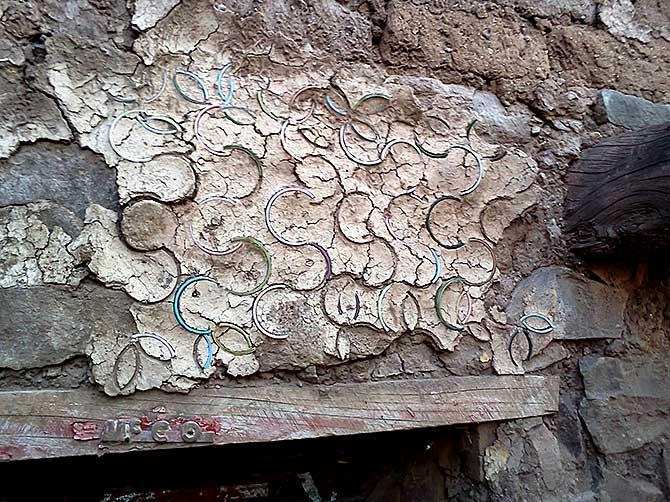
While studying in college, the duo were influenced by one of their professors, a senior architect, Malaksingh Gill who believed in eco-friendly, culture-sensitive architecture and wanted his students to question and use their skills more responsibly.
Incidentally, Gill is a student of the famous British-Indian architect Laurie Baker who is known for his low cost, sustainable buildings in India and often involved his students in engaging project work.
During their fourth year of college, Dhruvang's batch had visited a small village near Faltan in Satara to explore local housing and architecture. The incident left an indelible mark.
"A few kilometers away from the village, the people had suffered from extreme drought that year. Each house would receive only two buckets of water per week from a tanker and it would cost them Rs 10 per bucket," he describes the experience that changed his life.
"We were invited inside a mud house where an old woman lived alone. She told us how she'd built the house with her bare hands. The poor lady had embedded broken bangles into the cow dung plastered walls to give it a personal touch."
"As she spoke, the ten of us were drawing sketches to understand how people built houses in areas where there was scarcity of water. When we were about to leave the house, the lady offered to make tea for all of us."
Dhruvang was touched by her gesture.
"Her genuine hospitality taught us a lesson I would never forget. I no longer wanted to sit in an air conditioned office and make drawings and sketches on a computer, disconnected with reality. I wanted to connect people to their roots," he said.
"People who live in Marathwada and Vidarbha regions of Maharashtra know how to build houses with what is available and with minimum wastage -- be it water, sand or stones. That's because they value their resources," he says.
"Since we live in cities, we don't really think or question about how these resources are made available to us. We must learn to respect and not abuse our natural resources."
Interesting learnings

The couple use lime and mud, stone and bricks, traditional labour and sustainable, locally available resources to build homes.
One of their first projects in Kamshet encouraged them to push their boundaries and look for innovative methods.
"We studied the area to understand the raw materials available and how it would measure up against the weather conditions. We employed nearby villagers and baeldaars (labourers) to help us build the house. We have been taught to avoid or minimise the use of machine labour, and encourage village economy. The first time we saw them use traditional methods to break stones, we were amazed at the skills they had. It's a lot of hard work and comes from years of practice, so they deserve to be appreciated and employed. You'll be surprised the quarry made bricks pale in comparison to their perfection to the craft and skill," Higmire says.
They used stone masonry (black stone with mud mortar) for the ground floor which he says keeps the foundation strong and protects the structure during monsoons.
After seven feet, the local labourers used bricks bound together with adobe bricks, made from earth, clay and hay.
The house had a small attic on top, built from mud, bricks and wood.
Instead of the expensive and conventional teak wood, the roof was made from a local timber called 'ain'.
To meet the client's requirement, the couple chose to go for lime plasters over cement to make it more sustainable.
"Unlike cement, lime is completely recyclable and possesses a greater thermal insulation value -- it traps heat during summer and releases it during winter," Dhruvang explains.
But there are challenges too, he says.
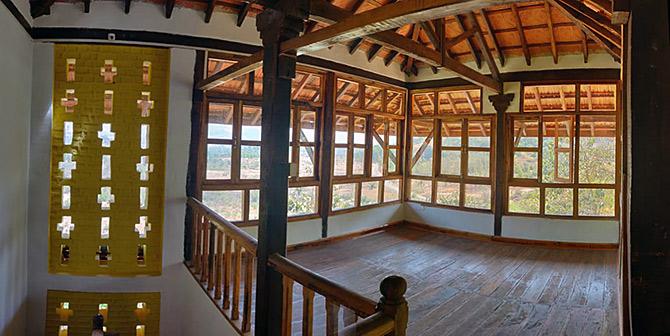
"Most masons don't want to go out of their comfort zone. They have been working in a certain way all these years, so the first time you tell them to do something different, they'll resist. But if you can convince them and the client, it saves everyone a lot of money."
A major drawback that comes with mud housing, Dhruvang says, is the thickness.
"A strong mud house will mean thicker walls, which may not be recommended in metros where the carpet area is already very small. But on the bright side, there are people like Laurie Baker who have designed corporate structures in the middle of the city that are sturdier, cost effective and sustainable. His Rat Trap bond (structured bents in walls), for example, helps increase strength of a structure which can be used in cities. By using holes in the wall, Baker ensured light and air would pass through, also keeping the structure cooler," he elaborates.
Today, the couple may not be getting 50 per cent lesser projects than their fellow batchmates. But they are happier and satisfied with the quality of work they do.
"We work closely with the local masons and labourers. The charm of building a house with your hands gives a different high," says the couple who continue to be inspired by the works of people like Laurie Baker, 90, DD Contractor -- he is 80 plus now, lives in Himachal Pradesh and Biju Bhasker (of Thannal, who builds hand sculpted homes)who have been quietly contributing to the environment and leading the way.
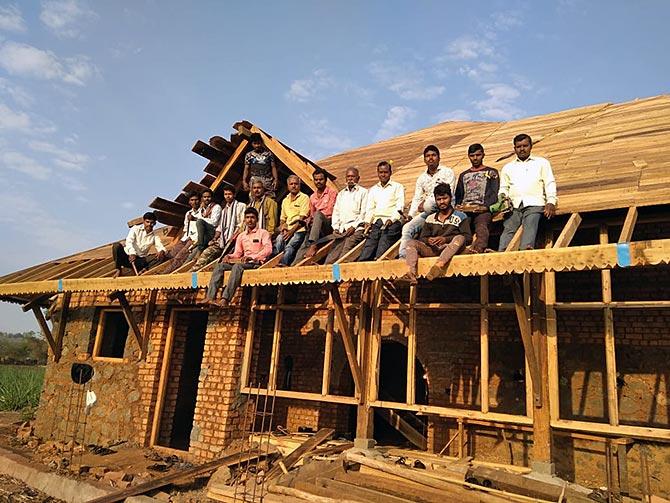
"We live in cities where there are dams to cater to our water needs, we don't think about the scarcity of water in villages and how it affects the farms and farmers," he points out.
Through their projects, the duo appeal citizens people to be "more proactive and question how we use and abuse our natural resources", so we can save them for future generations.
"As architects, we have a huge responsibility in influencing and executing ideas with the people we work with," Dhruvang wants to tell young architects.
"It is important to question your decisions at every stage -- where are we getting the sand from? What will it cost the environment? Can we add an extra step, tweak the design and make it more sustainable?"
"Our job isn't just to stand and give orders to people who can't read our drawings," shares Priyanka.
"We believe in minimal sketches and more inclusivity, innovation and functionality in our designs. The idea is to build it ourselves, so there is a personal touch and responsibility to the spaces we create."











